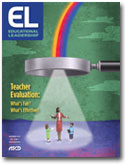School Leadership 2.0
A Network Connecting School Leaders From Around The Globe
How to Use Value-Added Measures Right by Matthew Di Carlo
November 2012 | Volume 70 | Number 3
Teacher Evaluation: What's Fair? What's Effective? Pages 38-42
How to Use Value-Added Measures Right
Matthew Di Carlo
How can districts that are required to use value-added measures ensure that they do so responsibly?
The debate is polarized. Both sides are entrenched in their views. And schools are caught in the middle, having to implement evaluations using value-added measures whose practical value is unclear.
Value-added models are a specific type of growth model, a diverse group of statistical techniques to isolate a teacher's impact on his or her students' testing progress while controlling for other measurable factors, such as student and school characteristics, that are outside that teacher's control. Opponents, including many teachers, argue that value-added models are unreliable and invalid and have absolutely no business at all in teacher evaluations, especially high-stakes evaluations that guide employment and compensation decisions. Supporters, in stark contrast, assert that teacher evaluations are only meaningful if these measures are a heavily weighted component.
JOIN SL 2.0
SUBSCRIBE TO
SCHOOL LEADERSHIP 2.0
Feedspot named School Leadership 2.0 one of the "Top 25 Educational Leadership Blogs"
"School Leadership 2.0 is the premier virtual learning community for school leaders from around the globe."
---------------------------
Our community is a subscription-based paid service ($19.95/year or only $1.99 per month for a trial membership) that will provide school leaders with outstanding resources. Learn more about membership to this service by clicking one of our links below.
Click HERE to subscribe as an individual.
Click HERE to learn about group membership (i.e., association, leadership teams)
__________________
CREATE AN EMPLOYER PROFILE AND GET JOB ALERTS AT
SCHOOLLEADERSHIPJOBS.COM
New Partnership
Mentors.net - a Professional Development Resource
Mentors.net was founded in 1995 as a professional development resource for school administrators leading new teacher induction programs. It soon evolved into a destination where both new and student teachers could reflect on their teaching experiences. Now, nearly thirty years later, Mentors.net has taken on a new direction—serving as a platform for beginning teachers, preservice educators, and
other professionals to share their insights and experiences from the early years of teaching, with a focus on integrating artificial intelligence. We invite you to contribute by sharing your experiences in the form of a journal article, story, reflection, or timely tips, especially on how you incorporate AI into your teaching
practice. Submissions may range from a 500-word personal reflection to a 2,000-word article with formal citations.


You need to be a member of School Leadership 2.0 to add comments!
Join School Leadership 2.0